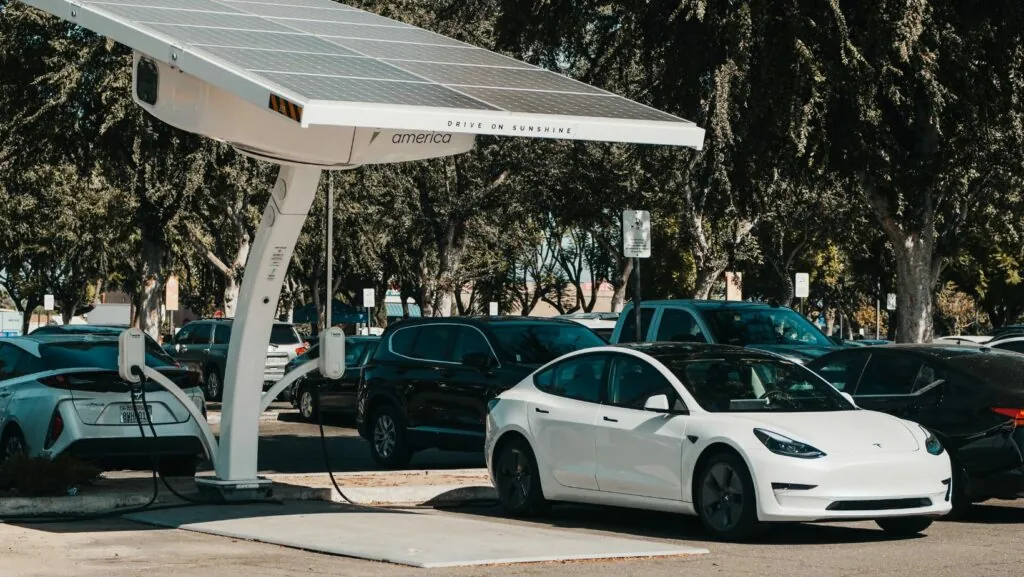In a world where gas prices can make your wallet feel lighter than your car’s trunk, electric vehicles are zooming into the spotlight. They’re not just a trendy choice; they’re a revolution on wheels. While gasoline vehicles guzzle fuel like a thirsty marathon runner, electric cars sip energy like a refined connoisseur enjoying a fine wine.
Table of Contents
ToggleOverview of Electric Cars and Gasoline Vehicles
Electric cars utilize electric motors powered by rechargeable batteries, while gasoline vehicles depend on internal combustion engines fueled by gasoline. This fundamental difference influences their performance and efficiency metrics significantly. Electric vehicles (EVs) convert over 60% of electrical energy from the grid to power at the wheels, showcasing superior energy efficiency. In contrast, gasoline vehicles achieve about 20% efficiency, as a significant portion of the energy gets wasted as heat.
Operating costs highlight further disparities. EVs typically cost less to operate per mile due to lower electricity prices and reduced maintenance requirements. Gasoline vehicles incur higher fuel costs and require regular oil changes and exhaust system maintenance. Battery life in electric cars also affects longevity and resale value, with many batteries lasting over 100,000 miles, while gasoline engines may face wear and tear sooner.
Moreover, environmental impact stands out distinctly. Electric cars emit zero tailpipe emissions, contributing to improved air quality. Gasoline vehicles produce harmful emissions, impacting public health and contributing to climate change. The shift toward renewable energy sources for electricity generation enhances the sustainability of EVs.
Charging infrastructure continues to expand, making EV use more practical. Home chargers offer convenience, while public charging stations appear increasingly in cities. In contrast, gasoline vehicles benefit from well-established refueling networks but depend on fossil fuels.
Overall, distinct operational mechanisms define electric vehicles and gasoline cars. Each type’s advantages appeal to different consumer preferences, shaping the automotive landscape. The ongoing advancements in technology further influence the choices drivers make today.
Power Sources
Electric vehicles and gasoline vehicles utilize distinct power sources, impacting their operational efficiency and environmental footprint.
Electric Vehicle Batteries
Electric vehicles depend on rechargeable batteries to supply energy to electric motors. Lithium-ion batteries dominate the market due to their ability to hold significant energy density, allowing cars to travel longer distances. One charge can provide an average range of 250 to 370 miles, depending on the model. Recharge times vary; home chargers can take several hours, while fast chargers may supply 80% of the battery in about 30 minutes. Battery technology continues evolving, aiming to enhance performance, reduce costs, and increase sustainability.
Internal Combustion Engines
Internal combustion engines, or ICEs, convert fuel into energy through combustion processes. Gasoline and diesel are common fuels used in these engines. Typically, an ICE operates at about 20% energy efficiency, losing much energy as heat during the process. Fuel combustion generates harmful emissions, contributing to air pollution and greenhouse gas concerns. The complexity of ICEs leads to higher maintenance needs compared to EVs, requiring oil changes and other frequent services that electric vehicles generally avoid. Manufacturers are increasingly seeking cleaner alternatives, yet ICE dominance remains prominent in the automotive industry.
Performance Differences
Electric vehicles (EVs) and gasoline vehicles exhibit notable performance differences that significantly impact driving experiences. EVs capitalize on instant torque, resulting in quicker acceleration compared to combustion engine vehicles.
Acceleration and Speed
Acceleration sets electric cars apart from gasoline vehicles. Instant torque from electric motors allows EVs to reach higher speeds rapidly. EVs typically accelerate from 0 to 60 mph in just 3 to 5 seconds, depending on the model. Contrastingly, gasoline vehicles may take 6 to 8 seconds to achieve the same speed. This responsiveness enhances driving enjoyment, especially during city driving or merging onto highways.
Efficiency and Range
Efficiency plays a critical role in the performance of EVs. Electric vehicles achieve over 60% energy efficiency, making them more efficient than gasoline cars, which operate at around 20% efficiency. Most modern EVs offer ranges between 250 to 370 miles on a single charge. In comparison, gasoline vehicles provide varying ranges depending on fuel efficiency, commonly ranging from 300 to 500 miles per tank. The disparity in efficiency and range significantly influences consumer choices when considering performance options.
Emissions and Environmental Impact
Electric vehicles (EVs) significantly change the emissions landscape in transportation. These cars produce no tailpipe emissions, contributing to improved air quality in urban areas. Emissions-free operation benefits public health, particularly in regions with high traffic congestion. Additionally, the shift towards renewable energy sources for electricity generation can further reduce the overall carbon footprint of EVs.
Zero Emissions of Electric Cars
Zero emissions define electric cars’ environmental impact. Battery-powered vehicles generate no harmful pollutants during operation. The reliance on renewable energy for charging diminishes their overall greenhouse gas emissions substantially. In fact, studies show that EVs can lead to emissions reductions of up to 70% compared to traditional gasoline vehicles when factoring in the electricity production process. As charging infrastructure expands, the potential for further reducing emissions increases, aligning electric cars with global sustainability goals.
Emissions from Gasoline Vehicles
Gasoline vehicles emit significant pollutants contributing to environmental degradation. Internal combustion engines produce carbon dioxide, nitrogen oxides, and particulate matter with every mile driven. These emissions worsen air quality, contributing to respiratory issues and climate change. Research indicates that gasoline cars generate approximately 4.6 metric tons of carbon dioxide annually per vehicle. Transitioning to EVs can substantially decrease these harmful emissions, leading to a healthier environment and a more sustainable future.
Maintenance and Longevity
Maintenance plays a crucial role in the longevity of both electric and gasoline vehicles. Understanding the distinct needs of each type helps owners make informed decisions.
Electric Vehicle Maintenance Needs
Electric vehicles (EVs) require minimal maintenance compared to their gasoline counterparts. Owners typically focus on battery health, which may involve software updates and monitoring battery performance. Regenerative braking systems often reduce wear on brake pads, extending their lifespan significantly. Tires also need regular rotation and inflation checks to avoid uneven wear. Annual inspections are recommended but usually involve fewer components than those of gasoline vehicles. This streamlined maintenance process contributes to lower overall service costs for EV owners.
Gasoline Vehicle Maintenance Requirements
Gasoline vehicles demand more frequent maintenance due to their complex internal combustion engines. Owners should expect regular oil changes, typically every 3,000 to 5,000 miles, to ensure engine health. Additionally, fuel system cleaning and spark plug replacements are necessary to maintain optimal performance. Timing belt replacements, depending on mileage, can also incur significant costs. Brake pads and fluid changes are essential for safety and performance, adding to maintenance requirements. Overall, gasoline vehicles often involve higher upfront maintenance costs over time, impacting long-term ownership expenses.
Electric vehicles are reshaping the automotive landscape with their unique operational advantages. Their efficiency and lower environmental impact make them a compelling choice for consumers looking to reduce their carbon footprint. As technology advances and charging infrastructure expands, the appeal of EVs will only grow.
The differences in maintenance requirements further highlight the practicality of electric cars. With reduced upkeep costs and the promise of a cleaner future, electric vehicles are not just an alternative but a necessary evolution in transportation. The shift toward electric mobility represents a significant opportunity for both consumers and the planet.




